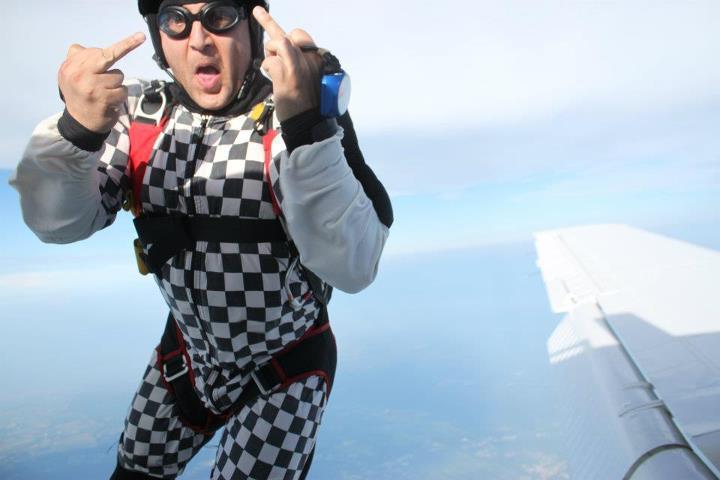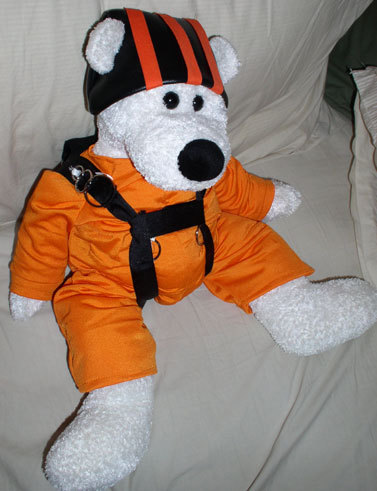Recommended Posts
piisfish 140
do I understand correctly, you were upwind, and trying so bad to get back to the DZ, you overshot it by 3 miles, never looking back ?QuoteYes I was freaked out and keept trying to "push" forward to the DZ.
You see I was blown to the DZ....and then right over it and then right past it.
if so, a GAP WEDGE is what you need
you still did a good jod by landing safely in an unexpected place. Just a quick question, at what altitude did you decide where you were intending to land ?
QuoteHe is a pot stirring shit / troll.
I wish he would find another place to play.
Skydiver? Give me a break!
HE IS AN ASS!
The Forum Rules:
No personal attacks.
No jokes about or references to pedophilia. None.
No advertising in the forums.
Post to the correct forum and stay on topic.
Sparky
QuoteYou'll probably get a couple of days vacation from here Don. I did last week.
So you have a little time to alter or delete.
I got 3 days for a similar comment towards him. Worth it to me, YMMV
So its fine, he can degrade women stir shit and do what ever the fuck he can to offend the users of this site and the moment we react negatively to his offensive posts we get banned???
I think Shah is the one needing a vacation and not Don.
Just my 2c
nigel99 574
What thoughts do you have about simply stalling the canopy and simply dropping to a safe height? It's going to beat spirals, fronts and possibly holding. Obviously there is an element of risk that it doesn't recover gracefully from the stall - in which case you get the bonus of extra freefall after you cut away ![]()
With regards to spirals if you integrate the speed and direction, the net speed due to the canopy is 0 and you are left with the wind speed. If you hold into the wind your speed is wind speed less canopy speed meaning you get better results.
But it sounds more like a lack of experience in reading groundspeed, I know I still struggle to gauge my downwind run in higher winds.
QuoteQuoteIf you face into the wind the whole time, you cover very little ground, and leave yourself very few options
Ah ok!
Yes I was freaked out and keept trying to "push" forward to the DZ.
You see I was blown to the DZ....and then right over it and then right past it.
So turn around and get a better picture?
Thank you!
There it is!! DUHHHHH!!!!
NOT duhhhh.
Situational awareness, my friend. There is no automatic answer for this situation.
Case in point, and yes it has happened all too often.
Turn and run......too far....past the big huge LZ or pasture....and into the woods or tarmac or whatever.
You evaluate the situation. You pick the best option that you can get to by either holding OR running OR crabbing OR a combination of all and/or other techniques to land safely. And you start this the instant you realize that your flight plan is not going to go as planned.
Shah landed safely even if it was accidental or not.
Could have done better? Maybe. We don't know but given his description of what he DID do, I guess yes...he could have done better.
TO SHAH:
Freaked out because you didn't know what to do.
There's a cure for that. Can you guess?
Knowledge and skill development.
Take charge of your learning...it's YOUR ass!
As an aside. Don't let the haters get to you. Sometimes people forget what it was like when THEY were young jumpers. Sometimes they forget that THEY could have been considered 'idiots' too.
Also, some people only see the messenger and not the message. Let it blow by you. No need to get all involved with that attitude.
I guess I'm trying to say to continue posting this type of stuff. For young jumpers, "There are no stupid questions." Wait until you get knowledgeable, then you can be posting stupid shit.
Your post here was good stuff and presented a good learning opportunity for yourself AND others.
Thanks.
I think we're all Bozos on this bus.
Falcon5232, SCS8170, SCSA353, POPS9398, DS239
QuoteWhat thoughts do you have about simply stalling the canopy and simply dropping to a safe height?
You laugh. It HAS been done. It also has been done to just do the cutaway and deploy the reserve lower.
QuoteWith regards to spirals....gauge my downwind run in higher winds.
Blah, blah, blah...freakin' engineers. K.I.S.(for the) S.
I think we're all Bozos on this bus.
Falcon5232, SCS8170, SCSA353, POPS9398, DS239
skybytch 273
QuoteWrong. Brakes are best when you're upwind. Downwind, getting small and using rears is all the hope you've got of getting back.
Rears into a headwind aren't going to get you anywhere. Try it and see.
QuoteWrong again. 359 degrees of every spiral you are not facing the wind. If you are worried about getting pushed back, face directly into the wind.
Wrong again. Spiraling down will get you out of the wind flow. You won't make more forward penetration, but you won't get blown back as far aince you are not exposed to the wind for as long.
sundevil777 102
QuoteWhat thoughts do you have about simply stalling the canopy and simply dropping to a safe height? It's going to beat spirals, fronts and possibly holding.
I don't know if you'll descend faster than a spiral. A single front riser turn/dive might beat both of them.
Choosing to just descend fast is a very different strategy than fronts and holding, so I think it is somewhat misleading to say it "beats" them. It depends on the circumstances to decide which strategy is better. Different wind speeds at different altitudes, or if worse weather is approaching...
QuoteObviously there is an element of risk that it doesn't recover gracefully from the stall - in which case you get the bonus of extra freefall after you cut away
With regards to spirals if you integrate the speed and direction, the net speed due to the canopy is 0 and you are left with the wind speed. If you hold into the wind your speed is wind speed less canopy speed meaning you get better results.
That may not be true, which is the point in saying that sometimes it can be better to be blown back by the full wind speed for a short time than blown back by some fraction of the full wind speed for a longer time.
I am not saying that spiraling to lose altitude is often a good choice, not at all.
sundevil777 102
QuoteQuoteWrong. Brakes are best when you're upwind. Downwind, getting small and using rears is all the hope you've got of getting back.
Rears into a headwind aren't going to get you anywhere. Try it and see.QuoteWrong again. 359 degrees of every spiral you are not facing the wind. If you are worried about getting pushed back, face directly into the wind.
Wrong again. Spiraling down will get you out of the wind flow. You won't make more forward penetration, but you won't get blown back as far aince you are not exposed to the wind for as long.
(skybytch was actually replying to DaVinciflies).
Quotenotice you're downwind of your target after exiting the plane, right? Couldn't you just track back upwind before your intended opening altitude?
I know this was covered before, but I just want to make sure you understand the point.
When you leave the plane, if there are other jumpers or groups leaving the plane seperate from you, you have chosen your column of sky, and you need to stay in it. Proper group seperation will allow you some leeway to track away from others in your group, but certainly not enough to track any significant distance. If you track a significant distance, you run the risk of flying into the airspace of the group or jumper that exited before or after you.
Another idea some have had is to pull higher. In the case of being downwind of the DZ on a windy day, this is not going to help as pulling higher will increase the time your canopy is exposed to those winds. If you are upwind of the DZ, pulling high can make a difference, as you'll cover far more ground under canopy than in a track.
HOWEVER, in any case, when you leave the plane with other jumpers, or solo with an assigned pull altitude, it's up to you to stick to that plan for the sake of the other jumpers in the air with you. Just like you can't track too far up or down the jumprun, you also can't change your pull altitude mid-stream. Others in your group, or on the plane, have an expectation of what you are going to do and have made their own plans accordingly.
Now if you are in a group, and want to break off 500 or 1000 higher, and you can see that the others get the idea and also break off, you might be able to pull slightly higher, but you simply cannot just whip your PC any time you feel like it because you think you're too far from the DZ.
The correct solution is to maintain awareness of the wind conditions throughout the day, and check the spot before you exit.
The exception to the 'don't pull high rule' is in the case of an equipment malfunciton or other emergency where you need to stop the freefall. In that case, track clear from others in your group, give a good wave off (if able) and do what you need to do. Keep in mind that a bad spot, or having to land off, does NOT qualify as an emergency in these terms.
Quote
QuoteRears into a headwind aren't going to get you anywhere. Try it and see.
I am not making this up! I have tried it, and it works. Of course there will be a point where nothing is going to get you to penetrate the wind. That's the time to be on the ground!
With a few exceptions the rule is:
Tailwind - get small and use brakes.
Headwind - get small and use rears.QuoteWrong again. Spiraling down will get you out of the wind flow. You won't make more forward penetration, but you won't get blown back as far aince you are not exposed to the wind for as long.
This is quite simply wrong, and is a common misconception. Can someone who we respect around here as a canopy coach (Ian, AggieDave) chime in?
It is no wonder new jumpers are getting confused about canopy flight when there is some much misinformation around. I half expect someone to say "You should get big with a tailwind to act as a sail"!!
pchapman 279
QuoteQuoteWrong again. Spiraling down will get you out of the wind flow.
This is quite simply wrong, and is a common misconception.
Wrong, wrong again.
[Edit: I'm now not actually sure which part of the original unedited quote you were saying was wrong -- rears into a headwind, or spiralling. Your use of quotes didn't distinguish on that point. In any case:]
I would indeed GENERALLY advise noobs to face into the wind and not spiral down. It is more likely to work I bet.
In rushing to get down, people may underestimate how far they'll blow back. Just like noobs taking the downwind leg of their pattern way too far in strong winds, or throwing in a 360 and then finding themselves way far downwind.
But one can easily come up with scenarios where the spiral down works better.
For example, compare two cases. Someone is on a big boaty canopy that does 25 mph, and sinks at an easy 800 fpm. They have 2000' of distance to drop through high winds (whether that's to near the surface or just a level where they abate).
Let's say that in a spiral they can triple their rate of descent to 2400 fpm, or about 27 mph downwards. I don't know offhand what it might actually be, but I don't think that is overstating things even for a big slow draggy canopy.
If our jumper is facing 35 mph winds, he's pushing back 10 mph and will be exposed to the wind 2.5 minutes, pushing back 2200'. If he spirals, he's only exposed 0.83 min, but drifting at the full 35 mph, and drifts back more, 3080'. The three times increase in descent rate didn't make up for the 3.5 times increase in drift rate.
But, if the winds were an extremely strong 50 mph at altitude, he is faced with drifting back 25 mph or 50 mph. There, speeding up the descent rate 3 times is of a net benefit compared to "only" doubling the drift backwards. Facing the wind he drifts back 5500', but only 3650' if spiralling.
So in conclusion, facing the wind is usually the way to go, in situations where you are only getting pushed back slowly. It may feel scary for a noob, but spiralling will then be bad because they'll drift with the full speed of the wind.
But in extreme cases where you already are drifting back fast, and you can increase your descent rate by a greater degree than the drift-back increases, then spiralling will better. This applies more for the slowest canopies (accuracy, student) in unusually high wind conditions.
Hope this mathematical treatment helps.
ufk22 33
QuoteQuote
QuoteRears into a headwind aren't going to get you anywhere. Try it and see.
I am not making this up! I have tried it, and it works. Of course there will be a point where nothing is going to get you to penetrate the wind. That's the time to be on the ground!
With a few exceptions the rule is:
Tailwind - get small and use brakes.
Headwind - get small and use rears.QuoteWrong again. Spiraling down will get you out of the wind flow. You won't make more forward penetration, but you won't get blown back as far aince you are not exposed to the wind for as long.
This is quite simply wrong, and is a common misconception. Can someone who we respect around here as a canopy coach (Ian, AggieDave) chime in?
It is no wonder new jumpers are getting confused about canopy flight when there is some much misinformation around. I half expect someone to say "You should get big with a tailwind to act as a sail"!!
Yes, with advice like thiis it IS no wonder that noobs get confused.
The way to deal with a situation where you are flying into the wind and getting pushed backward is to INCREASE the forward speed of your canopy. Pulling rears SLOWS the forward speed of your canopy. Pulling front risers will INCREASEE the forward speed of your canopy, although you'll give up altitude faster in exchange for speed. Using rears to fight a headwiind is simply WRONG.
As to spiraling down, it's not uncommon for winds above 3000' to be blowing much faster than surface winds. Where I jump we often see a big drop below 500', but a noticeable drop below 3000'. Assuming surface winds below 20mph, spiraling down quickly out of the higher winds at higher altitudes (especially if you are open at 5000') will often help. This is the same reason that RW groups get more drift from winds in freefall than head-down groups, less time exposed. If the winds are steady from the surface all the way up, then spiralling won't help.










Share this post
Link to post
Share on other sites